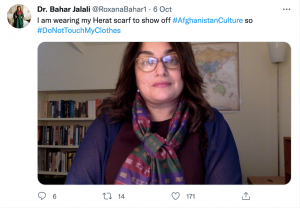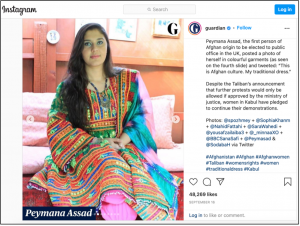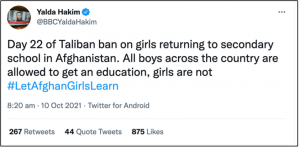#AfghanWomen post pictures of themselves wearing traditional attire on Twitter and Instagram seeking to defend the image of a woman in #AfghanistanCulture. This social media campaign of the recent months seeks to address current human right violations and gender-directed restrictions imposed by the Taliban rule. How do ICTs (information and communication technologies) empower women who are “living challenging lives in difficult contexts” (O’Donnell and Sweetman, 2018, p.220)?
Expat voices
The online protest revolves around #DoNotTouchMyClothes and #AfghanistanCulture hashtags. It was started in September, following women led street demonstrations in major cities in Afghanistan, by an international development expert and gender specialist, former history professor at the American University in Kabul Dr. Bahar Jalali (see her Twitter and LinkedIn profiles). Dr. Jalali is now based in Baltimore where she is affiliated with the Loyola University Maryland (check out their respective interview from 23 September, 2021 here).

Breaking news
“As a key instrument for publicity, journalism helps recognize and legitimize human rights violations as they unfold. In this sense, it gives human rights collectives a vehicle for immediacy, recognition, and agenda setting while also serving as a platform for branding and fund-raising” (Ristovska, 2021, p.178).
Back in mid-September I came across this campaign while casually scrolling through my feed on Instagram. The Guardian post I first saw presented its article reporting on the #DoNotTouchMyClothes campaign. The post has since received more than 48k likes.

This protest is an example of how “online communications can post breaking news and almost instantaneously create movements to challenge injustices” (O’Donnell and Sweetman, 2018, p.224). Traditional media picks up on online activism and then their messages make international headlines. Here are some examples:
- BBC, Afghan women hit back at Taliban with #DoNotTouchMyClothes campaign, 2021-09-13
- CNN, Afghan women are sharing photos of dresses to protest the Taliban’s black hijab mandate, 2021-09-13
- Reuters, ‘This is how we dress’: Afghan women overseas pose in colourful attire, 2021-09-15
- The New York Times, #DoNotTouchMyClothes Afghan Women Protest Taliban Restrictions, 2021-09-29
- American Vogue, How One Afghan Woman Is Embracing Her Traditional Dress, 2021-10-05
As in any protest, sustaining media attention is of crucial importance, it is also a declared goal of #DoNotTouchMyClothes:

ICT4W: agency and ability
“In addition to collective action and mobilisation through #MeToo, local online campaigns like #mydressmychoice and #iwillgoout, have led to concrete actions and outcomes that benefit women” (O’Donnell and Sweetman, 2018, p.218).
Research shows that the ICT4D’s (information and communication technologies for development) potential to impact and ultimately change gender relations goes from removing focus on access and emphasizing empowerment (O’Donnell and Sweetman, 2018, p.220).
Studies (e.g., Hussain and Amin, 2018) revealed how women in urban areas of Afghanistan are prevented from exercising their ICTs enabled ‘transformative’ agency at a household level, when confronted with controlling and policing by men (O’Donnell and Sweetman, 2018, p.220). To unfold the transformative potential of ICTs for women (ICT4W), especially when addressing power and inequality, the “4As” (access, affordability, availability and awareness) have to be complemented by two more “As” – agency and ability (O’Donnell and Sweetman, 2018, p.220).
Digital platforms offer spaces to fight gender-based brutality and enable activists to achieve substantial changes around the world at local, national and global levels (O’Donnell and Sweetman, 2018, p.217). The #DoNotTouchMyClothes protest employs ICTs to restore social justice that is inseparable from gender equality. “Gender should be seen as a central issue in our understanding of ICTs in developing countries” (Walsham, 2017, p.26) and emphasis should be put on women as key players in ensuring diversity, equity and inclusion.
Have #AfghanWomen created a global movement?
“If development is seen as a process designed to enable people to free themselves from structural disadvantage, ICTs for development need to be seen in terms of their scope to help do this” (O’Donnell and Sweetman, 2018, p.219).
When marginalized groups are enabled to create content according to their own knowledge, then they do “challenge the racism, sexism, and post-colonial power inequalities that form part of the landscape of the online environment and the resources or content available” (O’Donnell and Sweetman, 2018, p.222). Social media offers a platform where these voices can be heard.
Moreover, digitally networked protests offer ability to organize without formal organizations, which “speeds things up and allows for great scale in rapid times” (Tufekci, 2017, p.xiii). Activism happening in and through the new media seeks to maintain the momentum of traditional media catching on and reporting their struggle. Finally, #DoNotTouchMyClothes is followed by #LetAfghanGirlsLearn hashtag that further expands its mission.

I am very interested to hear from ComDev colleagues and those who have more or direct experience with the topic in the comments section below.
—
Academic references:
- Hussain, F. and Amin, S. (2018) “’I don’t care about their reactions’: agency and ICTs in women’s empowerment in Afghanistan””. Gender and Development, 26:2, 249-265.
- O’Donnell, A. & Sweetman, C. (2018) “Introduction: Gender, development and ICTs”. Gender and Development, 26:2, 217-229.
- Ristovska, S. (2021) Seeing Human Rights: Video Activism as a Proxy Profession. Cambridge, MA: MIT Press.
- Tufekci, Z. (2017) Twitter and Tear Gas – The Power and Fragility of Networked Protest. New Haven, CT: Yale University Press.
